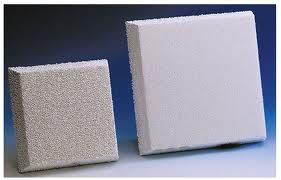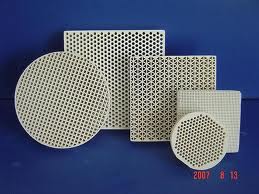Ceramic Filters
Ceramic filters are an inexpensive and effective type of water filter, that rely on the small pore size of ceramic material to filter dirt, debris, and bacteria out of water.
Method of action
As with most filtration methods, water is carefully introduced to one side of the filter, which acts to block the passage of anything larger than the pore size. Typically bacteria, protozoa, and microbial cysts are removed but the filters are not effective against viruses since they are small enough to pass through to the other "clean" side of the filter. Ceramic water filters (CWF) may be treated with silver in a form that will not leach away. The silver helps to kill or incapacitate bacteria and prevent the growth of mold and algae in the body of the filter. The two most common types of CWF are pot type and candle type filters. CWF systems consist of a porous ceramic filter that sits on top of a plastic or ceramic receptacle. Contaminated water is poured in the filter and passes through the filter into the receptacle below. The receptacle usually is fitted with a tap. Contaminants which are larger than the minute holes of the ceramic structure will remain in the top half of the unit, which can be cleaned by brushing the inside of the top section with a soft brush and rinsing it out. Hot water and soap can also be used. Some ceramic filters (like ceramic candle filters) also use active carbon which absorbs compounds such as chlorine. Filters with active carbon need to be replaced periodically because the carbon becomes clogged with foreign material.
There are also portable ceramic filters, such as the MSR Miniworks, which work via manual pumping, and in-line ceramic filters, which filters drinking water that comes through household plumbing. Cleaning these filters is the same as with the clay pot filter but also allows for reverse-flow cleaning, wherein clean water is forced through the filter backwards, pushing any contaminants out of the ceramic pores.
This filtration type does not remove chemical contaminants per se. However, some manufacturers incorporate a high-performance activated carbon core inside the ceramic filter cartridge that reduces organic & metallic contaminants. The major risks to the success of all forms of ceramic filtration are hairline cracks and cross-contamination. If the unit is dropped or otherwise abused, the brittle nature of ceramic materials can allow fine, hard to see cracks, and can allow larger contaminants through the filter. Extensive work on brittle nature and fracture toughness of these clay ceramic water filter materials. Also, if the "clean" water side of the ceramic membrane is brought into contact with dirty water, hands, cleaning cloths, etc., then the filtration will be ineffective. If such contact occurs, the clean side of the filter should be thoroughly sterilized before reuse.
Development and expansion
Several Universities including MIT; Universities of Colorado; Princeton University; The Ohio State University; Universities of Tulane, West Virginia, North Carolina in the US; University of Delft, Strathclyde in Europe, USAID, UNICEF, Zamorano University in Honduras, Rafeal Landivar University in Guatemala, Earth University, Institute of Hydraulic resources, Red Cross, Engineers Without Borders, United Nations, Countries in Africa like Nigeria, Ghana, Burkina Faso, Kenya etc. and Countries in Asia like Nepal, Bangladesh, Cambodia, Sri Lanka, India, Vietnam etc. and NGOs are supporting the expansion of the use of ceramic filters in drinking water development initiatives; most commonly, in the form of clay pot filters. Ron Rivera was a key proponent and innovator in the field as part of the group to take the ceramic frustum shaped(pot) filter across international borders and helped developing nations to provide cheap high quality potable water. Ron Rivera is not only credited with this but also taking Potters of Peace worldwide for the good and benefit of clay workers in developing nations to sustain their businesses.
Video


